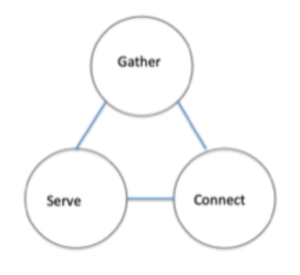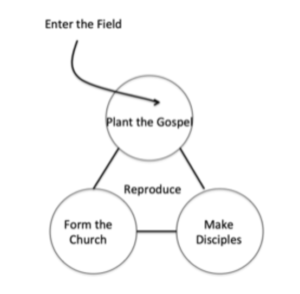
The Stop & Go Process of Disciple Making
What many churches call discipleship, or disciple-making is a far cry from what Jesus had in mind when He gave us the Great Commission. What you are doing may be the very reason your church is struggling when it comes to reaching non-Christians with the gospel.
I work with dozens of churches each year, helping them align their strategies and programming with their disciple-making results (measures). My observation is that most churches have three core components when it comes to their strategy. Most often, it consists of 1) a gathering where worship takes place, 2) groups where people connect and study the Bible, and 3) a place of service in the church. It may look like some variation of the drawing below.

This model most often assumes that people find their way into our gatherings, and the rest will take care of itself. The challenge to this assumption is that in today’s culture that people are no longer finding us. We have reached everyone like us or who is wants to be like us. If we are frank about our situation, if we are experiencing growth at all, it is usually the result of doing things better than the churches around us and reaching their attenders and members. In essence, we are growing at the expense of the churches around us, with little or no actual kingdom growth.
Think about it for a moment. We encourage disciples to gather for Christian worship on the weekends and then gather with a smaller group of Christian in our homes during the week for Bible Study. You may be wondering what’s wrong with this? Well, I’m glad you asked. Jesus didn’t save us to spend our lives in a holy huddle. The very commission he gave us begins with an imperative to “go.”
For Jesus, there was no separation in evangelism and disciple-making. Evangelism is simply the first part of a holistic process we refer to as disciple-making. Whenever I think of disciple-making, I process it through our pipeline that includes: pre-disciples, new-disciples, growing, disciples, multiplying disciples, and catalytic disciples. A healthy disciple-making culture will have both pre and new-disciples flowing through it.
A more open system for disciple-making might look like the one I use when working with leaders or catalytic disciples who are interested in catalyzing disciple-making movements.

This is what we call a strategy map, and it consists of five components. Here’s a super quick overview. I will save a fuller discussion for future writings.
Enter the Field
Jesus calls us to enter the fields that are already “white unto harvest”. We must be intentional about equipping disciples at every level of our pipeline to enter the harvest field. This may require a rethinking of how we relate to people where we live, work, and play.
Plant the Gospel
We plant the gospel by proclaiming the good news that in Christ, God did for us what we could not do for ourselves in that He redeemed us, He is renewing us, and He is ultimately going to restore all of creation. We plant the gospel by telling our story and telling His story of redemption. While the gospel may be demonstrated non-verbally through our actions, be not mistaken, the gospel is verbal. The gospel is a good news announcement that must be proclaimed.
Make Disciples
Once someone is open to the gospel, disciple-making begins. I was reminded the other day of a young man I disciple for two-years before he became a Christian. I did this by engaging in a relationship with him, having an honest dialogue where I answered his question, and introduce him to my broader Christian community. My disciple-making efforts consisted of exposing him to Gospel Truth, Gospel Community, and Gospel Mission. We did life-on-life, life-in-community, and life-on-mission together.
Form the Church
Once you begin making disciples, you can then form new communities or new churches around those disciples. When I first started this journey of church planting, I thought I needed to form a church and then go make disciples. What I have discovered in the post-church era is we have to make disciples and then form the church around those disciples.
Reproduce
The final part of our strategy is to reproduce. We reproduce other disciples, groups, churches, ministries, and networks. However, it’s important to note that reproduction begins in the pre-disciple phase. If we meet someone open to the gospel, then we can ask that person if he has family or friends that might be open to the gospel. When they do, we can encourage them to invite us into their network, and when this happens, they are learning to reproduce from day one.
Now let me ask you a question: Which one of these approaches to church is going to allow us to make disciples of people far from God? Hopefully, both, but certainly the open system, is going to be more effective in today’s context.

Tags: David Putman, Discipleship, disciple making












